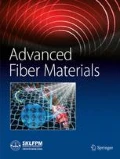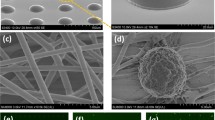Abstract
The analysis of circulating tumor cells (CTCs) allows a noninvasive method of “real-time liquid biopsy” from the blood samples of cancer patients for the diagnosis of early-stage cancer, prognosis, and monitoring therapeutic response. In this study, we develop a simple, inexpensive, and reliable method that utilizes a small molecule peptide, the asparagine-glycine-arginine (NGR), as a capture probe for the selective enrichment and isolation of circulating tumor cells (CTCs). The multiscale TiO2 nanofibers are obtained by electrospinning and calcination. Bovine serum albumin (BSA) is decorated onto TiO2 nanofiber surfaces to inhibit non-target cell adhesion, while NGR peptides are conjugated onto the TiO2-BSA surface through the glutaraldehyde (GA) to specifically capture the target cells. The TiO2-BSA-NGR substrate exhibits a high capture sensitivity and efficiency from the mimical blood samples with PC-3 cancer cells as low as 10 cells/mL. The TiO2 nanofiber substrate can be a promising strategy for the capture and enumeration of CTCs in cancer progression monitoring.
Graphic Abstract






Similar content being viewed by others
References
Shen Z, Wu A, Chen X. Current detection technologies for circulating tumor cells.Chem Soc Rev. 2017;46:2038.
Wang Z, Sun N, Liu M, Cao Y, Wang K, Wang J, Pei R. Multifunctional nanofibers for specific purification and release of CTCs. ACS Sens. 2017;2:547.
Fan X, Jia C, Yang J, Li G, Mao H, Jin Q, Zhao J. A microfluidic chip integrated with a high-density PDMS-based microfiltration membrane for rapid isolation and detection of circulating tumor cells. Biosens Bioelectron. 2015;71:380.
Gao W, Zhang X, Yuan H, Wang Y, Zhou H, Jin H, Jia C, Jin Q, Cong H, Zhao J. EGFR point mutation detection of single circulating tumor cells for lung cancer using a micro-well arrayBiosens Bioelectron. 2019;139:111326.
Lecharpentier A, Vielh P, Perez-Moreno P, Planchard D, Soria JC, Farace F. Detection of circulating tumour cells with a hybrid (epithelial/mesenchymal) phenotype in patients with metastatic non-small cell lung cancer. Br J Cancer. 2011;105:1338.
Zhao Y, Xu D, Tan W. Aptamer-functionalized nano/micro-materials for clinical diagnosis: isolation, release and bioanalysis of circulating tumor cells. Integr Biol. 2017;9:188.
Sun N, Li X, Wang Z, Li Y, Pei R. High-purity capture of CTCs based on micro-beads enhanced isolation by size of epithelial tumor cells (ISET) method. Biosens Bioelectron. 2018;1022:157.
Hu B, Rochefort H, Goldkorn A. Circulating tumor cells in prostate cancer. Cancers. 2013;5:1676.
Pantel K, Brakenhoff RH, Brandt B. Detection, clinical relevance and specific biological properties of disseminating tumour cells. Nat Rev Cancer. 2008;8:329.
Wang S, Wang H, Jiao J, Chen KJ, Owens GE, Kamei K, Sun J, Sherman DJ, Behrenbruch CP, Wu H, Tseng HR. Three-dimensional nanostructured substrates toward efficient capture of circulating tumor cells. Angew Chem Int Ed. 2009;48:8970.
Sun N, Li X, Wang Z, Zhang R, Wang J, Wang K, Pei R. A multiscale TiO2 nanorod array for ultrasensitive capture of circulating tumor cells. ACS Appl Mater Interfaces. 2016;8:12638.
Sun N, Liu M, Wang J, Wang Z, Li X, Jiang B, Pei R. Chitosan nanofibers for specific capture and nondestructive release of CTCs assisted by pCBMA brushes. Small. 2016;12:5090.
Liu H, Wang Z, Chen C, Ding P, Sun N, Pei R. Dual-antibody modified PLGA nanofibers for specific capture of epithelial and mesenchymal CTCs. Colloids Surf B Biointerfaces. 20199;181:143.
Sun N, Wang J, Ji L, Hong S, Dong J, Guo Y, Zhang K, Pei R. A cellular compatible chitosan nanoparticle surface for isolation and in situ culture of rare number CTCs. Small. 2015;11:5444.
Chen C, Wang Z, Zhao Y, Cao Y, Ding P, Liu H, Su N, Pei R. A folic acid modified polystyrene nanosphere surface for circulating tumor cell capture. Anal Methods. 2019;11:5718.
Zhang N, Deng Y, Tai Q, Cheng B, Zhao L, Shen Q, He R, Hong L, Liu W, Guo S, Liu K, Tseng HR, Xiong B, Zhao XZ. Electrospun TiO2 nanofiber-based cell capture assay for detecting circulating tumor cells from colorectal and gastric cancer patients. Adv Mater. 2012;24:2756.
Gorges TM, Tinhofer I, Drosch M, Rose L, Zollner TM, Krahn T, von Ahsen O. Circulating tumour cells escape from EpCAM-based detection due to epithelial-to-mesenchymal transition. BMC Cancer. 2012;12:178.
Wang Z, Sun N, Liu H, Chen C, Ding P, Yue X, Zou H, Xing C, Pei R. High-efficiency isolation and rapid identification of heterogeneous circulating tumor cells (CTCs) using dual-antibody-modified fluorescent-magnetic nanoparticles. ACS Appl Mater Interfaces. 20199;11:39586.
Li F, Yang G, Aguilar ZP, Xiong Y, Xu H. Affordable and simple method for separating and detecting ovarian cancer circulating tumor cells using BSA coated magnetic nanoprobes modified with folic acid. Sens Actuators B Chem. 2018;262:611.
Liu C, Xing J, Akakuru OU, Luo L, Sun S, Zou R, Yu Z, Fang Q, Wu A. Nanozymes-engineered metal-organic frameworks for catalytic cascades-enhanced synergistic cancer therapy. Nano Lett. 2019;19:5674.
Shen Z, Song J, Zhou Z, Yung BC, Aronova MA, Li Y, Dai Y, Fan W, Liu Y, Li Z, Ruan H, Leapman RD, Lin L, Niu G, Chen X, Wu A. Dotted core-shell nanoparticles for T1-weighted MRI of tumors. Adv Mater. 2018;30:1803163.
Wang X, Qiao X, Shang Y, Zhang S, Li Y, He H, Chen SZ. RGD and NGR modified TRAIL protein exhibited potent anti-metastasis effects on TRAIL-insensitive cancer cells in vitro and in vivo. Amino Acids. 20177;49:931.
Arap W, Pasqualini R, Ruoslahti E. Cancer treatment by targeted drug delivery to tumor vasculature in a mouse model. Science. 1998;279:377.
Tsukamoto H, Shibata K, Kajiyama H, Terauchi M, Nawa A, Kikkawa F. Aminopeptidase N (APN)/CD13 inhibitor, Ubenimex, enhances radiation sensitivity in human cervical cancer. BMC Cancer. 2008;8:74.
Li ZJ, Cho CH. Peptides as targeting probes against tumor vasculature for diagnosis and drug delivery. J Transl Med. 2012;10:S1.
Zhu LP, Jiang JH, Zhu BK, Xu YY. Immobilization of bovine serum albumin onto porous polyethylene membranes using strongly attached polydopamine as a spacer. Colloids Surf B Biointerfaces. 2011;86:111.
Dreyer DR, Miller DJ, Freeman BD, Paul DR, Bielawski CW. Perspectives on poly(dopamine). Chem Sci. 2013;4:3796.
Pop-Georgievski O, Popelka S, Houska M, Chvostova D, Proks V, Rypacek F. Poly(ethylene oxide) layers grafted to dopamine-melanin anchoring layer: stability and resistance to protein adsorption. Biomacromol. 2011;12:3232.
Ku SH, Ryu J, Hong SK, Lee H, Park CB. General functionalization route for cell adhesion on non-wetting surfaces. Biomaterials. 2010;31:2535.
Jiang J, Zhu L, Zhu L, Zhu B, Xu Y. Surface characteristics of a self-polymerized dopamine coating deposited on hydrophobic polymer films. Langmuir. 2011;27:14180.
Acknowledgements
This work was financially supported by the National Natural Science Foundation of China (21904135, 21575154, 21775160), the Natural Science Foundation of Jiangsu Province (BK20180250), the Science Foundation of Jiangxi Province (20192ACB21033), the CAS International Cooperation Key program (121E32KYSB20170025), the Jiangsu Province Six Talent Peaks program and the CAS/SAFEA International Innovation Teams program.
Author information
Authors and Affiliations
Corresponding authors
Ethics declarations
Conflicts of interest
The authors declare no conflicts of interest.
Rights and permissions
About this article
Cite this article
Chen, C., Wu, Z., Ding, P. et al. Peptide NGR Modified TiO2 Nanofiber Substrate for Circulating Tumor Cells Capture. Adv. Fiber Mater. 2, 186–193 (2020). https://doi.org/10.1007/s42765-020-00040-0
Received:
Accepted:
Published:
Issue Date:
DOI: https://doi.org/10.1007/s42765-020-00040-0




